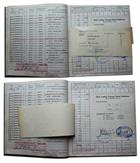Fleet Air Arm Aircraft 1939 to 1945 - Help Wanted
Help Wanted - did your relatives fly with the Fleet Air Arm in World War 2?
If so, you might be able to help naval aviation’s most dedicated historians.
Between them Lee Howard, Mick Burrow and Theo Ballance, along with the late Ray Sturtivant, are responsible for a series of definitive works on naval aircraft/units (Fleet Air Arm Fixed-Wing Aircraft since 1946, Fleet Air Arm Helicopters since 1943 and The Squadrons and Units of the Fleet Air Arm).
To mark the 70th anniversary of the end of World War 2, the trio hope to update the ‘bible’: Fleet Air Arm Aircraft 1939 and 1945., now a quarter of a century old and fetching upwards of £400.
That means charting and updating the history of somewhere in the region of 25,000 airframes – a daunting task made all the harder by the authorities who destroyed much of the official documentation shortly after the war’s end.
For the much improved and updated second edition, the team intended to put right any errors from the original version, cram in extra info and add scores of new photographs.
Aircrew logbooks (pilot, observer and telegraphist/air gunner) could help plug the gaps – as well as add to the Fleet Air Arm story.
Most fliers who survived the war kept hold of their logs; the books of those killed in action eventually ended up in the War Office’s document warehouse in Middlesex… until the beginning of the 60s when a clearout prompted some families to claim logs, but with hundreds more being pulped including, it is thought, those once belonging to Bismarck chase/Channel Dash hero Lieutenant Commander Eugene Esmonde VC DSO.
Despite the wholesale destruction of hundreds, if not thousands, of logbooks, over the years the FAA historians have pored over more than 2,000 such examples to help their research and are hopeful many more are still out there.
“While, on the face of it, many owners may think their logbooks contain no meaningful information, the devil is in the detail,” Lee explained. “Meticulous analysis can often extract the data needed to piece the histories of the aircraft and squadrons, as well as helping to highlight the sacrifices of those individuals involved.”
Although the emphasis for now is on wartime logbooks, the team are also keen to see logs – or copies – from post-war fliers from Suez and Malaya through the Falklands to Afghanistan, as well as long-running SAR duties in the UK to build up the knowledge base for future naval aviation reference books. Personal photos featuring wartime aircraft are also sought to help make this the most comprehensive book on the subject.
The team can be contacted via [email protected]


